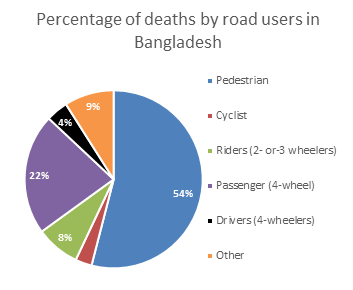InTrans / Apr 22, 2015
The more you know: Safety statistics around the world
Go! Magazine
 posted on April 22, 2015
posted on April 22, 2015
Did you know that one person is killed every 25 seconds around the world from a car accident? Road traffic accidents are the tenth-leading cause of death globally, killing 1.27 million people every year. The World Health Organization has projected that if nothing is done, deaths on the road could reach 2.4 million annually by the year 2030.
But why? Why so many accidents? Good question, but first we have to understand the “who” and “where.” A substantial amount of deaths caused by traffic accidents happen in developing countries, and further they happen to “vulnerable” populations. About half of all deaths globally happen to these types of people, a group that includes motorcyclists (23 percent), pedestrians (22 percent), and cyclists (5 percent).
Can we prevent this?
According to the World Health Organization, only seven percent of countries around the world have adequate safety laws currently in place. Many of the deaths could be drastically reduced by stricter laws around:
- Speeding
- Drunk driving
- Helmet usage
- Seat belts/child restraints
Did you know that many of the victims of road fatalities are from low-income countries? That they actually occur to people who don’t even own a car? In fact, 91 percent of total road fatalities happen in low- and middle-income countries, which makes up only 48 percent of the total registered vehicles globally. In other words, almost all of the fatalities involving cars occur where there are fewer cars per person. A lot can be done to help protect those non-drivers, including stricter rules on speeding, drunk driving, and helmets.
A 5 percent increase in speed has been shown to lead to a 10 percent increase in crashes with injuries and a 20 percent increase in fatal accidents.” (World Health Organization)
To understand the correlation between type of death by road user and income, I will compare two countries (one with low income and one with high income).
Bangladesh
Bangladesh has a population close to 159 million within 56,977 square miles, which makes it the 11th densest country by population. The country’s gross national income per capita is $470, making it a low-income country.

Did you know that the percentage of deaths by road user for 2006 included 3,160 fatalities? Additionally, 89 percent of the deaths happened to males, though the total number is likely to be an underestimate. Over 54 percent of fatalities happened to pedestrians.
Only 1,054,057 vehicles are registered in Bangladesh, covering only 0.6 percent of the population. Also, Bangladesh rated very low in terms of enforcement on speed limits, drunk driving, and motorcycle helmet laws. Seat belt and child restraint laws do not exist in this country.
United States
To compare with a country that most readers are familiar with, I chose the United States. The US has a gross national income per capita of $46,000, making it a high-income country.

The United States has a population of over 316 million. In 2006, 42,642 deaths by road traffic fatalities were reported. Of these fatalities, 70 percent were male. Almost three fourths of the road fatalities in the US happened to either drivers or passengers of four-wheel vehicles.
The US has over 251,422,509 registered vehicles, with an average of two cars per household. The US has rigorous laws regarding speed, drunk driving, and the use of helmets and seat belt/child restraints, which helps reduce fatalities overall.
Looking ahead
By understanding the relationship between road fatality and type of road user, a country can better address the issue. For example, it has been suggested Bangladesh focus on more land use planning to make a safer environment for pedestrians and cyclists. In the US, more focus has been placed on speeding, seat belt usage, and other factors important in reducing fatalities with accidents happening between two motor vehicles. In the next article, “The more you know: How countries are combating road fatalities” we will look at different laws that can help prevent some of the most prevalent road fatalities.
Related links
http://www.who.int/mediacentre/factsheets/fs358/en/
http://en.wikipedia.org/wiki/List_of_countries_by_traffic-related_death_rate
http://whqlibdoc.who.int/publications/2009/9789241563840_eng.pdf
By Jackie Nester, Go! Staff Writer